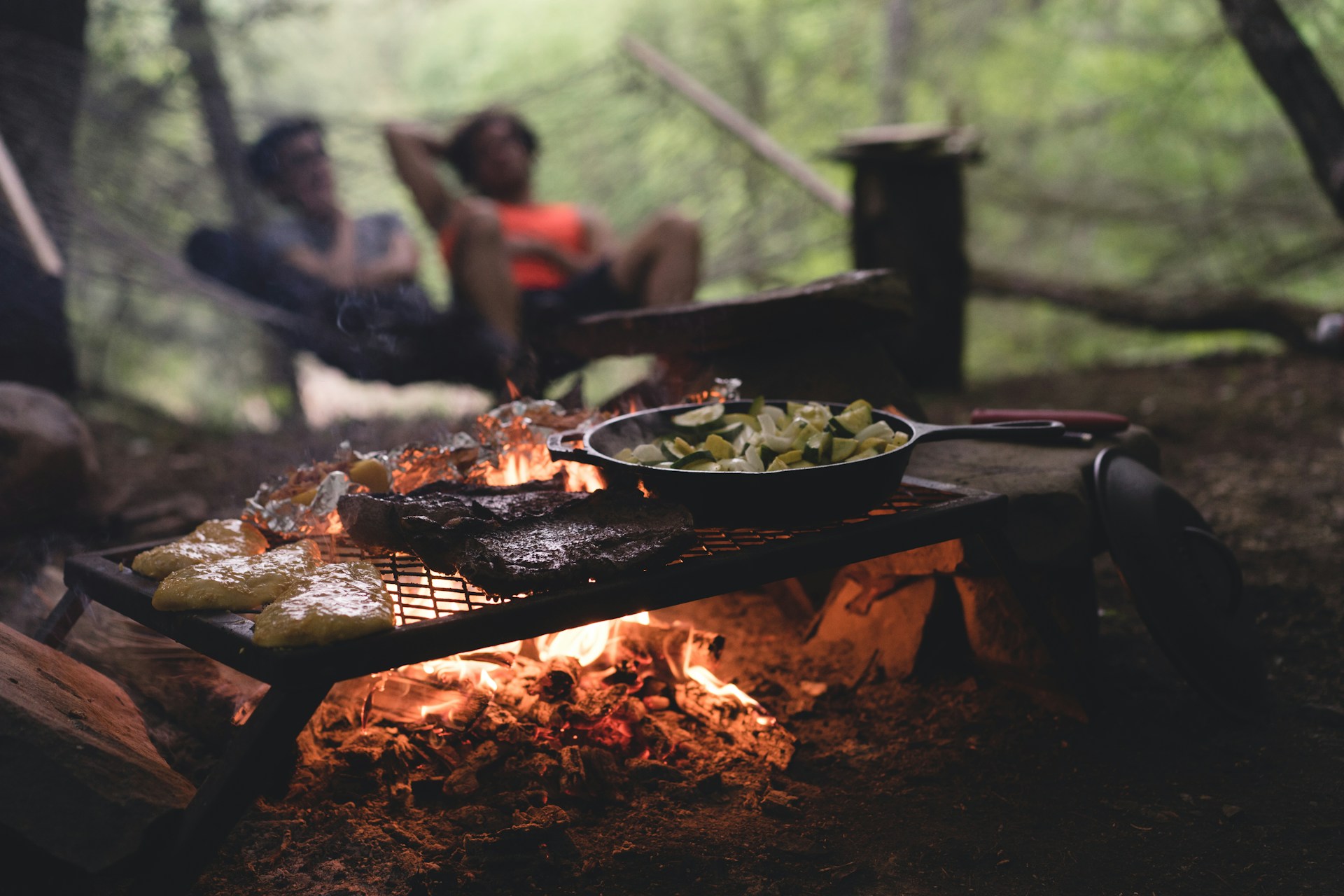
Few things hit the spot like a hearty meal in the great outdoors, especially after taking a vigorous hike and pitching a tent. Although you might initially find camping cooking intimidating, it’s often easier than prepping food in your kitchen — and creates far less cleanup. Here’s your camping cooking 101 crash course on what you need to know before heading into the wild.
Camping Cooking Equipment: What You Need, Where to Get It and How to Carry It
Your camping cooking setup starts with the right equipment — and the means to carry it into the wilderness.
Basic Camping Cooking Gear
Here’s the basic camping cooking gear deserving of a spot in everyone’s back frame:
- Waterproof lighter or matches, a flint and steel — basically, at least two means of starting a blaze
- A simple camp stove or fire grate
- A long-handled skillet or Dutch oven
- A combination spatula/scoop and a pair of tongs
- A knife
- A mitt, glove or cloth for touching hot things
- A personal mess kit — each camper should have a plate and silverware
- A trash bag
- A fire extinguisher and shovel

Optional Camping Cooking Gear
Of course, you can get more elaborate with your setup, especially if you drive to established campsites instead of backpacking into the backcountry. Salt, pepper and other condiments bring flavor to life. Here’s where to use all those packets of fast food ketchup and hot sauce piling up in your pantry, too. Put them in a baggie and slip them into your camping cooking gear.
Where to Get Camping Cooking Items
Your favorite local or online outfitter has a staggering array of gadgets, from full portable propane grills to solar ovens. If stocking a kit for mixing up camping meals on the fly, be sure to include a can and bottle opener, extra fuel for your camp stove, a small saucepan or pot for making coffee, a meat thermometer, aluminum foil, and additional trash bags.
How to Build a DIY Camp Stove
If you don’t have a multitool with a bottle opener, it pays to get one and clip it to your back frame. Everyone who camps should know this simple trick for creating an easy DIY stove. The only other supplies you need are an empty aluminum can, a can of camp stove fuel or a tea light candle. and a flat rock, which nature should provide.
Remove both ends of the empty can and use the bottle opener to punch airway openings around either perimeter. Place the can on the flat rock with a tea light or camp fuel inside and light it. Put your pan on top and heat your chili or stew. If you have duct tape, you can wrap it around one or both of the saved ends to create a trivet instead of using a rock to absorb the heat.
Schlepping Your Camp Cooking Gear to the Site
Carabiners are your friends — you can clip nearly all your basic camping cooking gear to your pack. If you need to drop weight for some reason, simply unclip the extra baggage and go. You probably have all the storage space you need if pulling your car or camper into a campsite.
Camping Cooking Safety
You must follow special camping cooking safety rules when in the wild to protect against fires and curious, hungry critters.

Wildfire Prevention Rules
First of all, heed all fire restrictions. You can do so by visiting your local Bureau of Land Management online or calling their 1-800 number. Always carry a fire extinguisher with you and have a water source nearby before sparking your blaze. Use established fire rings or grills if the campsite provides them.
Extinguish your blaze thoroughly before leaving the site, using your extinguisher, water and dirt to ensure no hot coals remain. Film yourself extinguishing the blaze so you have time-stamped proof — you don’t want the blame if a fire breaks out nearby.
Bear Safety 101
Your cooking doesn’t only smell delish to you. When camping in bear country, take the following precautions:
- Pitch your tent downwind of your cooking fire to minimize odor absorption.
- Keep all food and scented items out of your tent and in a bear-safe storage container, including that cherry chapstick.
- Clean up all food and scraps and deposit all waste in a bear-safe storage container. A more primitive alternative is the bear bag. Many established sites supply bins, but it’s a good trick to know in the backcountry.
- Remember — bears can break into cars, so work those bear-safe storage containers even when car camping.
A Taste of Camp Cooking: 5 Selected Recipes
When you’re ready to put your camping cooking skills to the test, whip up this 5-course menu and enjoy some mighty fine dining off the grid.
1. Best Steamers Outside of Maine
If you love seafood, your life is not complete until you enjoy a clambake over the campfire. Something about the smoke makes these mollusks even more delicious than when served as an appetizer at a 4-star restaurant. As an added bonus, clams have a high amount of vitamin B12, which contributes to brain function and better sleep. After your cookout, you’ll get a good night’s sleep at your campsite.
Method one involves wrapping them in aluminum foil with butter and lemon before you leave home. If adding potatoes, corn or sausage, cook the hard veggies before introducing the seafood. Method two is to add all three ingredients to your skillet and heat the clams until they open.
2. Easy Cowboy Chili Dogs
Camp cooking is easier when you mix up the chili before you leave home. All you really need are meat, beans, peppers and tomato sauce, but be as creative as you like.
Don’t like beef? Make a bean-only version, or try ground turkey, chicken or Beyond meat substitute. Plenty of cooler space? Include some toppings like corn salsa, grilled jalapenos and shredded cheese. Then, simply grill your dogs on your tongs or grate while heating the chili in your skillet. Add to a bun and enjoy.

3. Chickpea Veggie Hash
Here’s a side dish that doubles as a vegetarian main, thanks to the protein in the chickpeas. Mix the oil and seasonings with the chickpeas at home and store the veggies in a separate bag, blending them in the skillet as you heat this easy treat.
4. Campfire Popcorn
Campfire popcorn is a simple delight. There’s no need for store-bought chemical-laden yuck. Instead, add a scoop of coconut oil and your favorite organic popcorn blend to a generous piece of aluminum foil. Crimp the edges and attach to a stick — a bit of fishing line works fine. Pop over the fire.
5. Classic S’mores Campfire Skillet
S’mores are a classic campfire fave, but the marshmallows so often plunk into the fire. Instead, make yours dip-style using your skillet and enjoy sweet, coated fruit, pretzels and — of course — graham crackers.

Nourish Yourself Outdoors With These Camping Cooking Recipes
Camping cooking is easy to master once you know the basics. Much of it boils down to having the right gear and learning how to use it. Follow the applicable safety guidelines and modify your favorite recipes for the wild or slake your hearty post-hike appetite with new delights.
Anything you would add to Campfire Cooking 101?
Do you have ideas you found to be helpful when you first tried campfire cooking? Perhaps these could have been things you needed to learn by trial and error as you went. Or there were things you wish you had known before giving this a go. Do you have other recipes you have found to be great for the campfire? Please share your thoughts and impressions in the comments below.

Cora Gold
Cora Gold is a travel and lifestyle writer and the editor in chief of Revivalist magazine. She writes about travel inspiration, outdoor adventures and activities for women and families. Her work has been featured on Om Magazine, CafeMom and Parenthood and Passports.














Leave a Reply